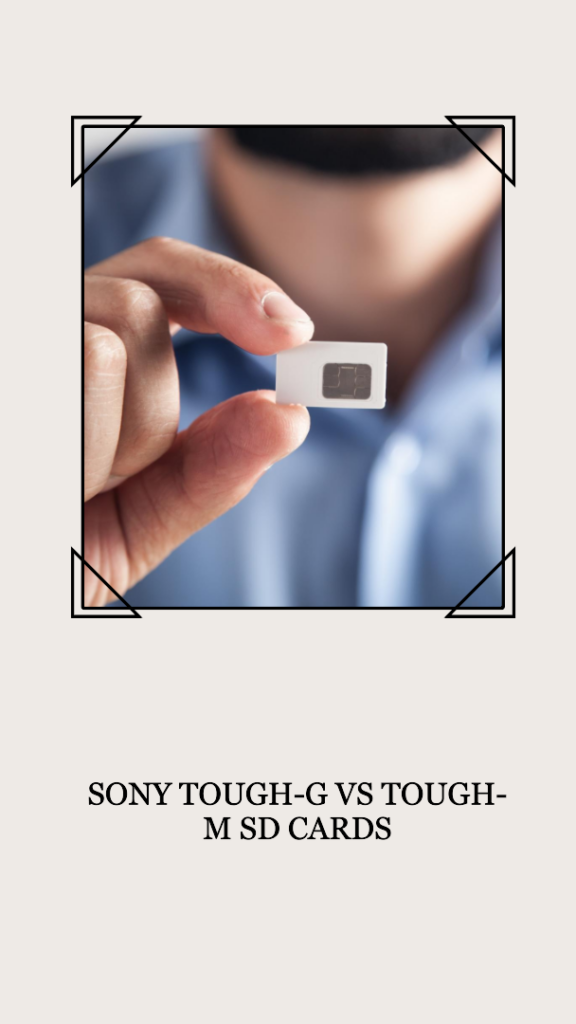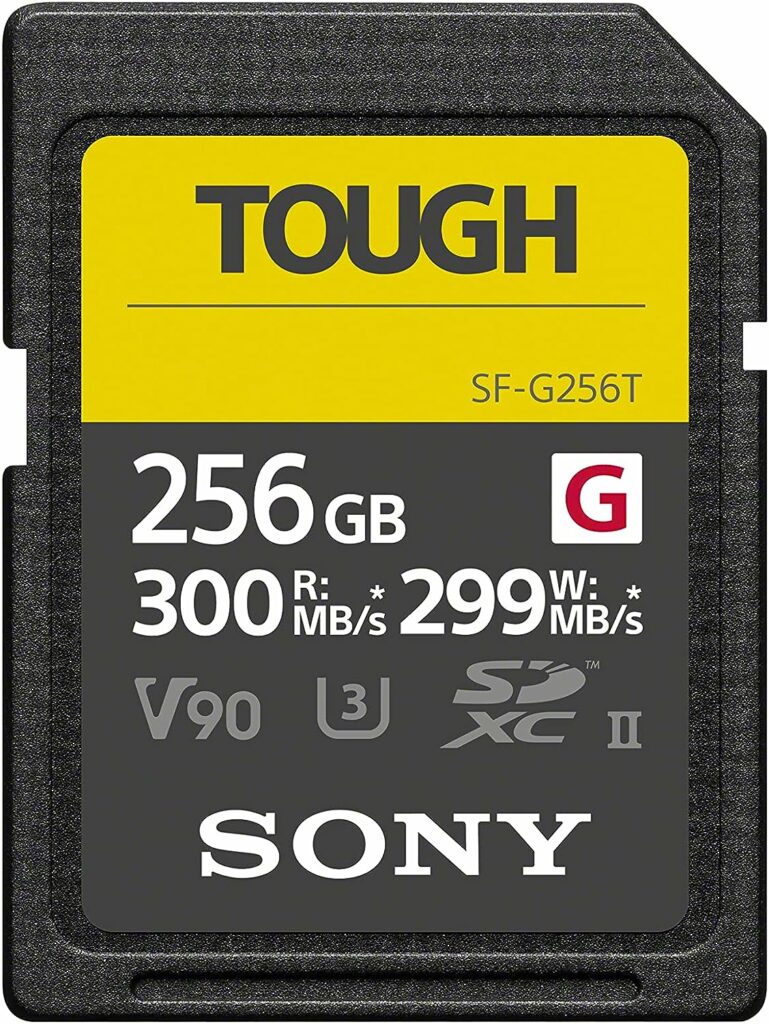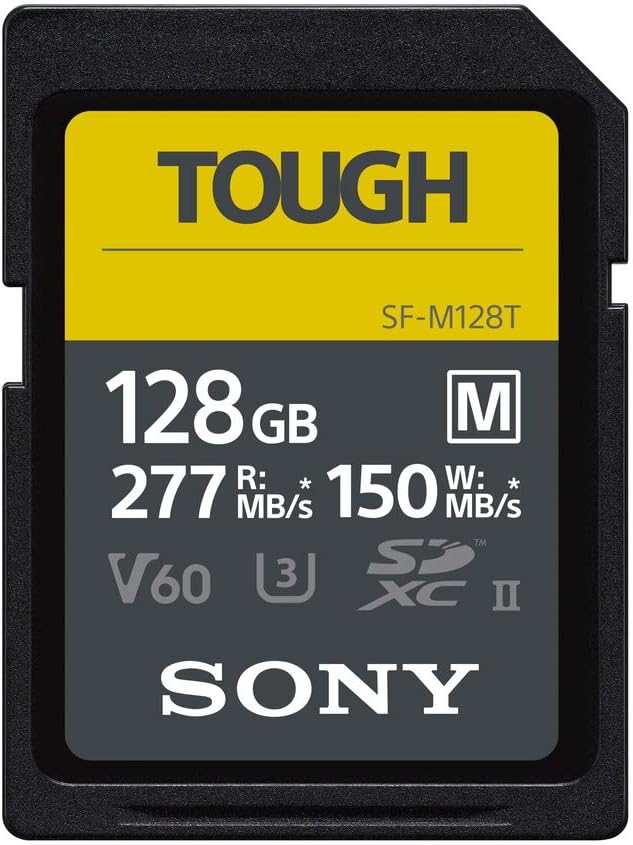This post compares the Sony TOUGH-G vs TOUGH-M SD Cards to understand their specs objectively.
Also Read: Best CFExpress cards – 8K & 4K
Sony’s foray into the world of SD cards has introduced two prominent series: the TOUGH-G and the TOUGH-M. Both these series have made waves in the tech community, but what sets them apart? Let’s comprehensively compare to understand their unique features and differences.
Also Read: Best V30 SD Cards

Quick Overview
- Speed: The TOUGH-G Series UHS-II SD Card boasts a slightly faster maximum reading speed in HD312 mode than the TOUGH-M Series. Moreover, the TOUGH-G’s top writing speed in HD312 mode is nearly double that of the TOUGH-M.
- Video Capability: With its V90 rating, the G series is apt for filming up to 8K videos. In contrast, with a V60 rating, the M series is more suited for up to 4K video capture.
- Capacity Options: Both series offer 64 GB and 128 GB options. However, the 32 GB variant is exclusive to TOUGH-G, while the 256 GB variant is unique to TOUGH-M.
Detailed comparison table: Sony TOUGH-G vs TOUGH-M SD Cards:
| Feature/Specification | TOUGH-G Series
Affiliate Disclosure: Lensxp.com is a participant in the Amazon Services LLC Associates Program. As an Amazon Associate we earn from qualifying purchases.
|
TOUGH-M Series |
|---|---|---|
| Capacity Options | 32 GB, 64 GB, 128 GB | 64 GB, 128 GB, 256 GB |
| Model Numbers (by capacity) | 32 GB: SF-G32 64 GB: SF-G64 128 GB: SF-G128T | 64 GB: SF-M64 128 GB: SF-M128 256 GB: SF-M256T |
| Usable Capacity (64 GB) | 57.6 GB | 57.6 GB |
| Usable Capacity (128 GB) | 115.2 GB | 115.2 GB |
| Interface | UHS-II | UHS-II |
| Format (32 GB) | SDHC | – |
| Format (64 GB & 128 GB) | SDXC | SDXC |
| SD Speed Class | Class 10 | Class 10 |
| UHS Speed Class | U3 | U3 |
| Video Speed Class | V90 (Suitable for 8K filming) | V60 (Suitable for 4K filming) |
| Read Speed (HD312 mode) | Up to 300 MB/s | Up to 277 MB/s |
| Read Speed (SDR104 mode) | Up to 95 MB/s | Up to 95 MB/s |
| Write Speed (HD312 mode) | Up to 299 MB/s | Up to 150 MB/s |
| Write Speed (SDR104 mode) | Up to 90 MB/s | Up to 90 MB/s |
| Supported Software | File Rescue, SD Scan Utility | File Rescue, SD Scan Utility |
| Operating Temperature Range | -13℉ to 185℉ | -13℉ to 185℉ |
| Dust and Waterproofing | IP68 (Up to 16 feet for 72 hours) | IP68 (Up to 16 feet for 72 hours) |
Detailed Breakdown
- Capacity Choices: The TOUGH-G series provides a 32 GB capacity option, whereas the TOUGH-M series offers a 256 GB capacity variant. Both series have 64 GB and 128 GB options available.
- Model Numbers:
- 32 GB TOUGH-G: SF-G32T
- 64 GB TOUGH-G: SF-G64T
- 128 GB TOUGH-G: SF-G128T
- 64 GB TOUGH-M: SF-M64T
- 128 GB TOUGH-M: SF-M128T
- 256 GB TOUGH-M: SF-M256T
- Usable Capacity: The 64 GB and 128 GB versions of TOUGH-G and TOUGH-M have identical usable capacities. For instance, the 64 GB variant for both series offers 57.6 GB of usable space.
- Interface & Format: Both series utilize the UHS-II interface. The 32 GB TOUGH-G uses SDHC, while the other variants in both series use the SDXC format.
- Speed Classifications: All SD cards in this comparison have a Class 10 rating, ensuring a minimum SD write speed of 10 MB per second. The TOUGH-G and TOUGH-M have a U3 rating, indicating a minimum UHS speed of 30 MB per second.
- Software Support: Both series support File Rescue and SD Scan Utility software. File Rescue aids in recovering accidentally deleted files, while the SD Scan Utility helps monitor the health status of the SD card.
- Operating Conditions: TOUGH-G and TOUGH-M can operate in temperatures ranging from -13℉ to 185℉. Additionally, both SD cards have an IP68 rating, ensuring complete protection against dust and the ability to withstand being submerged underwater up to 16 feet for a maximum of 72 hours.
Pros and Cons: Comparison table for the Sony TOUGH-G and TOUGH-M SD card series:
| Feature/Specification | TOUGH-G Series | TOUGH-M Series |
|---|---|---|
| Pros | ||
| Capacity Options | Offers a smaller 32 GB option | It provides a larger 256 GB option |
| Read Speed (HD312 mode) | Faster at up to 300 MB/s | Slightly slower at up to 277 MB/s |
| Write Speed (HD312 mode) | Significantly faster at up to 299 MB/s | Slower at up to 150 MB/s |
| Video Speed Class | V90 rating suitable for 8K filming | V60 rating ideal for 4K filming |
| Cons | ||
| Capacity Options | It lacks a 256 GB option | It doesn’t offer a 32 GB option |
| Read Speed (HD312 mode) | – | Slightly slower compared to TOUGH-G |
| Write Speed (HD312 mode) | – | Significantly slower than TOUGH-G |
| Video Speed Class | – | Lower rating, less suitable for 8K |
Key Takeaways:
- TOUGH-G Series: This series is more performance-oriented, offering faster read and write speeds, making it suitable for tasks that require quick data transfer, such as 8K video filming. However, it lacks the larger 256 GB storage option.
- TOUGH-M Series: While it offers a broader range of storage options, including a larger 256 GB variant, its read and write speeds are slower than the TOUGH-G series. It’s more suited for tasks like 4K video filming.
Final Thoughts
Sony’s TOUGH-G and TOUGH-M SD cards are both formidable contenders in the storage realm. While the TOUGH-G seems to have a slight edge in terms of speed and video capabilities, the TOUGH-M offers more extensive storage options. Depending on your specific needs, either card could perfectly fit your tech arsenal.

 Check on Amazon
Check on Amazon Check on Amazon
Check on Amazon